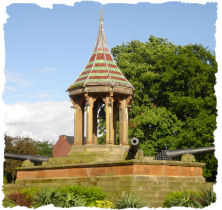
Public Urban Arboretums
![]() hrough the advocacy of landscape gardeners such as Paxton, Curtis and Loudon, arboretums played a part in the establishment of the first public parks. Scores of arboretums were established either as public parks in their own right or as part of larger public parks and gardens in towns such as Derby (1840), Nottingham (1852), Ipswich (1853), Walsall (1873), and Worcester (1859).
hrough the advocacy of landscape gardeners such as Paxton, Curtis and Loudon, arboretums played a part in the establishment of the first public parks. Scores of arboretums were established either as public parks in their own right or as part of larger public parks and gardens in towns such as Derby (1840), Nottingham (1852), Ipswich (1853), Walsall (1873), and Worcester (1859).
These public arboretums and parks drew upon the tradition of British landscape gardening but had a major impact upon the modern townscape and urban living, aiming to extend what had largely been the preserve of the landed gentry to the middle and working classes whilst symbolising and celebrating scientific progress.
Much less expensive than major public health reforms and favoured by all political groups even if sources of funding remained contentious, they were a response to the problems of industrialisation and rapid urban expansion, part of the rational recreational movement with galleries and mechanics institutes, and apiece with Ruskin’s attempt to utilise the mood of architecture to restore the ‘loss of fellowship with nature’.
Arboretums were an attempt to restore the equilibrium with nature and recreate a romantic rural idyll, however small and transitory, and in the urban landscape. In this sense, they were as Sinclair remarked, landscapes of curiosity where visitors could wander through distant climes and circumnavigate the globe in the space of a few acres.
As Charles Kingsley observed of galleries, they were ‘the townsman’s paradise of refreshment’ where in a single space he could ‘take his country walk- a walk beneath mountain peaks, blushing sunsets, with broad woodlands spreading below it; a walk through green meadows, under cool mellow shades, and overhanging rocks, by rushing brooks’.
In this way the urban dweller was able to wander ‘out free, beyond the grim city-world of stone and iron, smokey chimneys, and roaring wheels, into the world of beautiful things’.
However, the intention was that they did more than merely find transitory solace, according to the discourse of rational recreation, arboretums, parks and museums would offer moral and spiritual regeneration for the middle and working classes, reinvigorating family life and returning individuals stimulated to reinvigorate urban society as a whole.
